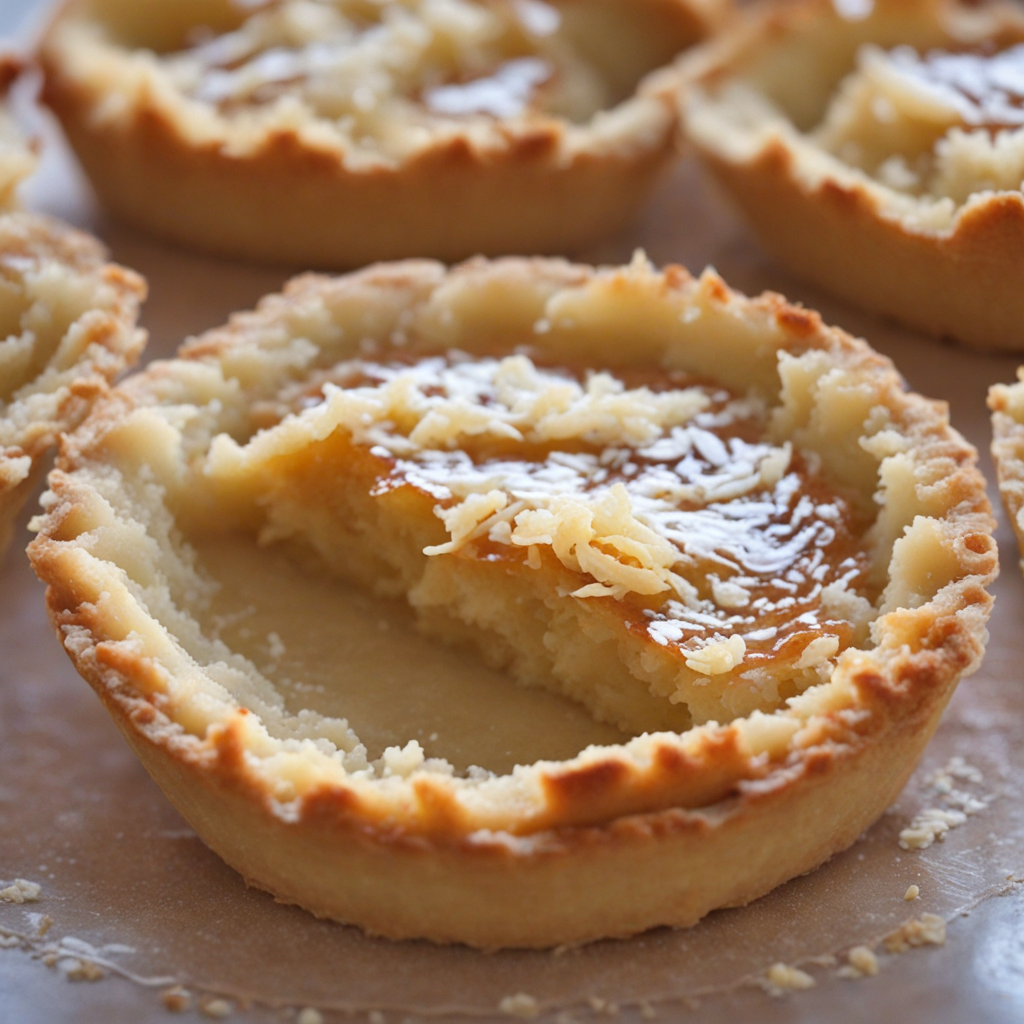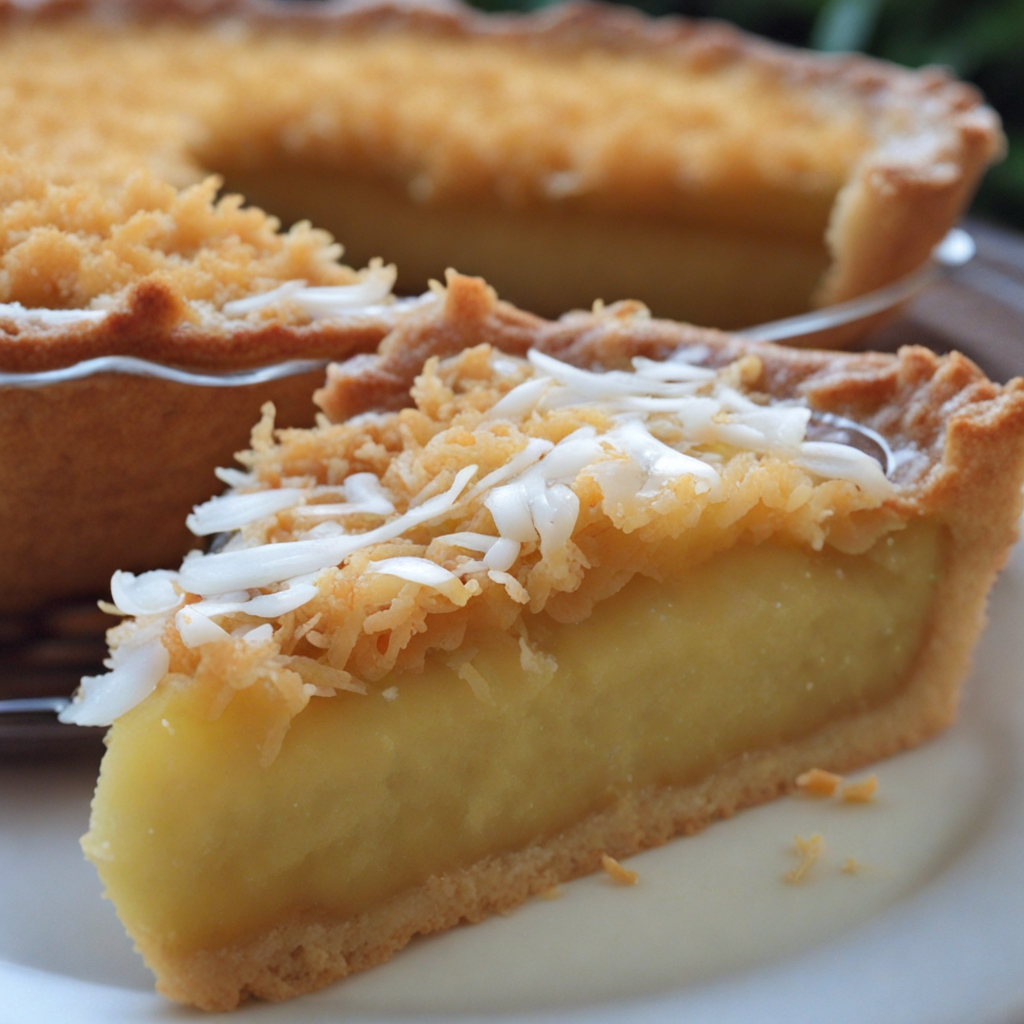Coconut Tart
Coconut Tart is a delightful dessert that embodies the tropical essence of Antigua and Barbuda. This treat features a flaky, buttery crust that serves as the perfect foundation for the star ingredient: fresh, grated coconut. The crust is typically made using simple pantry staples, making it both accessible and easy to prepare. Once baked, it transforms into a golden hue, inviting you to take a bite into its tender layers. The filling is a luscious mixture of sweetened coconut, eggs, milk, and sometimes a hint of vanilla or nutmeg, which enhances the natural sweetness of the coconut. As it bakes, the filling becomes rich and custardy, creating a beautiful contrast with the crisp tart shell. Each slice reveals a moist interior, fragrant with coconut's tropical aroma, delivering a taste that is both familiar and exotic. Served warm or at room temperature, Coconut Tart is often enjoyed with a dollop of whipped cream or a scoop of vanilla ice cream, making it an indulgent treat for any occasion. Its unique flavor profile captures the essence of the Caribbean, transporting you to sun-soaked beaches with every bite. For those seeking a new culinary adventure, this dessert promises a delightful experience that showcases the rich culinary traditions of Antigua and Barbuda.
How It Became This Dish
The Coconut Tart is a beloved dessert that holds a special place in the culinary landscape of Antigua and Barbuda. Its origins can be traced back to the islands' colonial history, where a fusion of European, African, and indigenous culinary practices began to shape the region’s gastronomy. The tart itself is a reflection of the Caribbean's rich history, with coconuts being one of the most ubiquitous ingredients found throughout the islands. Coconuts were introduced to the Caribbean by early explorers and traders, who recognized the fruit's versatility and nutritional value. As the coconut tree flourished in the tropical climate, local communities began to incorporate the fruit into their diets, using it in various forms—fresh, dried, and as coconut milk. The introduction of the coconut to sweet pastries and tarts is believed to have been influenced by European baking traditions, particularly from the British, who brought their own recipes and techniques to the islands. Over time, locals adapted these recipes to include local ingredients and flavors, creating a unique culinary identity. The Coconut Tart typically consists of a sweet pastry crust filled with a mixture of grated coconut, sugar, eggs, and spices, creating a rich and creamy filling that contrasts beautifully with the flaky crust. This tart is often flavored with vanilla, nutmeg, or cinnamon, which enhances its tropical sweetness. The combination of textures—the crunchy crust and the soft, chewy filling—makes it a delightful treat enjoyed by both locals and visitors alike. Historically, the tart has been associated with celebrations and special occasions in Antigua and Barbuda. It is often served at family gatherings, weddings, and festivals, where it symbolizes hospitality and the joy of sharing food with loved ones. The tart’s popularity can also be attributed to its simplicity; it is relatively easy to prepare, making it accessible for home cooks. As a staple of Antiguan and Barbudan cuisine, it reflects the islands’ resourcefulness in using readily available ingredients to create delicious and satisfying dishes. The cultural significance of the Coconut Tart extends beyond its taste. It represents the melding of different culinary traditions and the resilience of the people of Antigua and Barbuda. The tarts are often made during the Christmas season, where they are part of a larger array of festive foods that highlight the islands' culinary heritage. This tradition of preparing coconut tart during the holidays underscores its role in community bonding and cultural continuity, connecting generations through shared experiences and recipes. As the islands have evolved, so too has the Coconut Tart. In recent years, there has been a resurgence of interest in traditional Caribbean foods, with chefs and home cooks alike experimenting with new variations of the classic recipe. Modern interpretations may include the addition of tropical fruits, such as mango or passion fruit, or even the incorporation of chocolate, offering a contemporary twist on the traditional tart. These innovations not only celebrate the essence of the original dish but also showcase the dynamic nature of Caribbean cuisine as it continues to adapt and grow. Moreover, the rise of eco-tourism and a growing interest in Caribbean culture have led to increased recognition of traditional foods like the Coconut Tart. Culinary tourism has become an important aspect of the islands' economy, drawing visitors eager to experience authentic flavors and dishes. This interest has sparked a revival of traditional cooking classes and workshops, where local chefs share their knowledge of preparing classic recipes, including the beloved tart. In addition to its role in culinary tourism, the Coconut Tart embodies the agricultural heritage of Antigua and Barbuda. The cultivation of coconuts has been a vital part of the islands' economy, providing livelihoods for many families. Sustainable farming practices are increasingly being promoted to ensure that the coconut industry continues to flourish, allowing future generations to enjoy this essential ingredient. This connection to local agriculture reinforces the importance of supporting local farmers and preserving traditional cooking methods. As we look to the future, the Coconut Tart stands as a testament to the enduring legacy of Antigua and Barbuda's culinary traditions. The tart not only serves as a delicious dessert but also as a symbol of the islands' rich cultural heritage, resilience, and adaptability. It is a dish that invites us to explore the stories and flavors of the Caribbean, reminding us of the importance of food in shaping our identities and communities. Through its journey from colonial kitchens to modern dining tables, the Coconut Tart encapsulates the spirit of Antigua and Barbuda—vibrant, diverse, and deeply rooted in history. As it continues to evolve and inspire new generations of cooks, this delectable tart will undoubtedly remain a cherished part of the islands' culinary tapestry for years to come. Whether enjoyed at a festive celebration or as a casual snack, the Coconut Tart will forever hold a sweet spot in the hearts of those who savor its unique flavor and cultural significance.
You may like
Discover local flavors from Antigua And Barbuda







